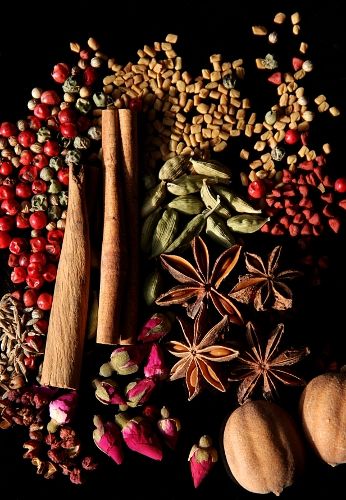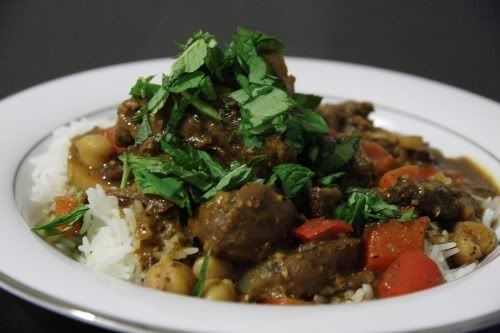Here's what you'll need:
2 lbs. goat meat
2 oz minced garlic
1 oz minced ginger
4 dried omani limes
1 bottle of apricot ale
1 oz dried apricots, chopped
2-4 sun dried tomatoes, chopped
12 cardamom pods
3-4 star anise
1 cinnamon stick
1 T annatto
1 T turmeric
1 T fenugreek
1 T dried rosebuds (can be had from Whole Spice)
1 1/2 t green peppercorns
1 1/2 t pink peppercorns
1 1/2 t coriander seeds
1 t cumin
1 t szechuan peppercorns
1/4 t nutmeg
1/4-1/2 c chick pea flour (besan) roux
Red bell peppers/onions/carrots, diced
Balsamic vinegar for deglazing
Fresh fenugreek leaves, cilantro, and/or mint for garnish

If you've never had goat before, it's worth a try. It's not gamey or strong-tasting at all. It's kind of hard to describe what it is like, so I won't even try, but if you like beef, you'll probably like goat. It generally has lots of bones in it (sharp ones, too) and is pretty tough, so you'll want to either use a pressure cooker or let it stew a long, long time. I opted for the pressure cooker to get it started, and then let it stew for a little less time (two hours, I think). If you can't get (or don't want) goat, then beef will work just fine.
The first time I made this, I seared the goat in the pot first and then added everything else after that, but because of the crazy amount of bones in the meat, I think a better approach is to treat it like you're making Pho- put the meat/bones in a large pot and cover with a couple inches of water; blanch for about 5 minutes and then drain. Here's where the pressure cooker comes in super handy- like 'if I didn't have one, I'd buy one' handy. Put the blanched meat/bones in the pressure cooker, cover with a couple inches of water and let it get up to full pressure, then turn the heat down and let it cook on low pressure for 15-20 minutes. Release the pressure however you want, then drain and save the liquid. When the meat cools, you can fairly easily pull all the meat off of the bones. Goat really is pretty tough, so if you don't have a pressure cooker this step will take quite a bit longer. Or you could just use beef. Or lamb, I guess. But this is my recipe, so goat it is. Before you return the meat and reserved liquid to the pot, pour in a little olive oil and sauté the garlic and ginger in it. Next add in the turmeric and let cook for about 20 seconds, then deglaze with some balsamic vinegar. (The first time I made this recipe, I added the turmeric directly to the pot full of liquid, but it clumped up and was hard to mix in thoroughly. The second time I made it, I added it to the ginger/garlic sauté and it of course worked much better. Coincidentally, I've since read that you're supposed to do it that way with turmeric anyway.) I used 'pomegranate infused' balsamic for the deglaze, just because I had it on hand, but I don't think it's anything special, at least this brand (Pompeian). I think next time I might just use regular balsamic and add pomegranate molasses to the stew while it's cooking. When the garlic/ginger/turmeric is ready, add in the goat and reserved cooking liquid. At this point the goat is only covered by an inch or two of water so you'll definitely want to add more. But the thing is- and this is why I really shouldn't start drinking until after I'm done working on a new recipe- I can't remember how much I used. I made it in an 8 qt. pot, and I think I filled it to about the halfway point. It probably doesn't matter much anyway; it's going to have to stew awhile, so you can likely get away with too much water- just let it reduce more. But for now, filling the 8 qt. pot to about halfway is my recommendation.
Next, drop in your dried limes, but pierce them in at least two places first. An instant-read thermometer works well for this. Add in your dried apricots, sun-dried tomatoes, and apricot ale. (You can probably get away with using more sun-dried tomatoes than what I used; I went with two because the ones I got- from the same international market where I got the goat- were not like 'regular' sun-dried tomatoes; these were dark, almost black, and very, very salty. If I'd been using the kind you see at most grocery stores I probably would have used several more.)
Now, don't make the mistake I did the first time I made this and just add your cardamom pods, star anise, and cinnamon stick right into the pot. That makes for a lot of hassle later on when you're constantly biting down on woody, chewy bits; toss them in a spice bag before adding them to the pot. I highly recommend the nylon ones that you can find at any homebrew shop, since they're almost always bigger and way cheaper than the cotton ones specifically designated as 'spice bags.' Add in the rest of the spices. If you're using whole spices (which you should be) you'll definitely want a coffee grinder, or at least something other than a mortar and pestle to grind them; most of them are no problem, but annatto seeds are hard. Really hard. I gave up after about 5 seconds in the mortar. Just wasn't worth it.
Once you have all that in the pot, bring it just to a boil, then turn it down to a simmer and let it go for at least an hour. At some point, maybe about 45 minutes into it, get your chickpea flour roux going. Don't use regular flour. It'll work, probably, but besan is so much better in this. It has a great, nutty flavor and really adds a lot of depth to the dish. Before I added the roux, I tasted the stew and was a little iffy about it. It wasn't bad at all, but really needed something. Turns out what it needed was the besan roux. Be aware that besan needs a bit more time to cook than regular flour, since it's very, very raw tasting. You'll definitely want to taste it before adding it to the stew, just to be sure. When it's ready, mix it in and let it simmer for 20-30 minutes or so, then give it a taste. At this point, the dish is still (probably) around 45 minutes away from being done. (Taste a piece of the goat to really get a better idea- chances are, you can go quite a bit longer and it'll be fine. What you don't want to do is overcook the veggies.) When you figure it's about 30 minutes away from being done, sauté your carrots/peppers/onions, deglaze with more balsamic, and then add them to the pot. Notice I didn't specify an amount. That's because I was too busy drinking at the time to bother remembering to do that. But it's not exactly critical- 1, or maybe 2, of each should be plenty. If you happen to have any chick peas lying around, those go well in this too. When the goat is nice and tender, and the veggies too, you're good to go. (Be sure and fish out the limes. Or leave them in if you feel like playing a joke on someone. They'll be nice and mushy and the color will blend in with everything else, so they'll almost surely go unnoticed. Especially if it's at night and you're trying to impress a date by candlelight.) Goes well by itself, but is good with flatbread, or especially over rice. Fresh fenugreek leaves make a nice garnish, if you can find them. They don't have an especially strong flavor, but they smell like snap peas, or fresh garbanzo beans. (The Cohort thought they smelled like walnuts, but I didn't really pick up on that.) If you can't find them, fresh sesame leaves are awesome too. Lacking that, mint is nice, and cilantro is especially good.

